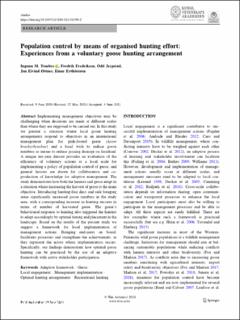| dc.contributor.author | Tombre, Ingunn | |
| dc.contributor.author | Fredriksen, Fredrik | |
| dc.contributor.author | Jerpstad, Odd | |
| dc.contributor.author | Østnes, Jan Eivind | |
| dc.contributor.author | Eythórsson, Einar | |
| dc.date.accessioned | 2021-07-21T08:54:46Z | |
| dc.date.available | 2021-07-21T08:54:46Z | |
| dc.date.created | 2021-06-30T11:47:27Z | |
| dc.date.issued | 2021 | |
| dc.identifier.citation | Tombre, I. M., Fredriksen, F., Jerpstad, O., Østnes, J. E. & Eythórsson, E. (2021). Population control by means of organised hunting effort: Experiences from a voluntary goose hunting arrangement. Ambio. doi: | en_US |
| dc.identifier.issn | 1654-7209 | |
| dc.identifier.uri | https://hdl.handle.net/11250/2764861 | |
| dc.description.abstract | Implementing management objectives may be challenging when decisions are made at different scales than where they are supposed to be carried out. In this study we present a situation where local goose hunting arrangements respond to objectives in an international management plan for pink-footed geese (Anser brachyrhynchus) and a local wish to reduce goose numbers as means to reduce grazing damage on farmland. A unique ten-year dataset provides an evaluation of the efficiency of voluntary actions at a local scale for implementing a policy of population control of geese, and general lessons are drawn for collaboration and coproduction of knowledge for adaptive management. The study demonstrates how both the hunters and geese adapt in a situation where increasing the harvest of geese is the main objective. Introducing hunting-free days and safe foraging areas significantly increased goose numbers in the study area, with a corresponding increase in hunting success in terms of number of harvested geese. The geese’s behavioural response to hunting also triggered the hunters to adapt accordingly by optimal timing and placement in the landscape. Based on the results of the present study we suggest a framework for local implementation of management actions. Bringing end-users on board, facilitates processes and strengthens the achievements, as they represent the actors where implementation occurs. Specifically, our findings demonstrate how optimal goose hunting can be practiced by the use of an adaptive framework with active stakeholder participation. Adaptive framework Geese Local engagement Management implementation Optimal hunting arrangements Recreational hunting | en_US |
| dc.language.iso | eng | en_US |
| dc.publisher | Springer | en_US |
| dc.rights | Navngivelse 4.0 Internasjonal | * |
| dc.rights.uri | http://creativecommons.org/licenses/by/4.0/deed.no | * |
| dc.subject | optimal hunting arrangements | en_US |
| dc.subject | adaptive framework | en_US |
| dc.subject | local engagement | en_US |
| dc.subject | recreational hunting | en_US |
| dc.subject | management implementation | en_US |
| dc.title | Population control by means of organised hunting effort : Experiences from a voluntary goose hunting arrangement | en_US |
| dc.type | Peer reviewed | en_US |
| dc.type | Journal article | en_US |
| dc.description.version | publishedVersion | en_US |
| dc.rights.holder | © 2021 The Author(s) | en_US |
| dc.subject.nsi | VDP::Zoologiske og botaniske fag: 480 | en_US |
| dc.subject.nsi | VDP::Zoology and botany: 480 | en_US |
| dc.source.pagenumber | 15 | en_US |
| dc.source.journal | Ambio | en_US |
| dc.identifier.doi | 10.1007/s13280-021-01590-2 | |
| dc.identifier.cristin | 1919534 | |
| dc.relation.project | The Norwegian Research Council: 207968 | en_US |
| dc.relation.project | The Norwegian Research Council: 230329 | en_US |

